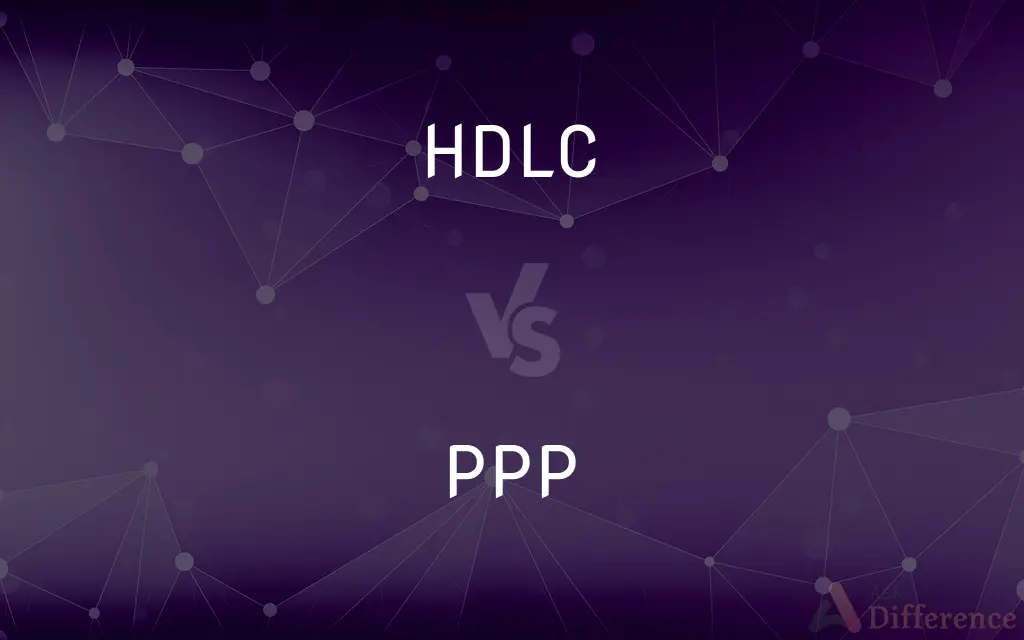HDLC vs. PPP — What's the Difference?
By Tayyaba Rehman — Published on January 6, 2024
HDLC (High-Level Data Link Control) is a bit-oriented protocol for communication over point-to-point and multipoint links, while PPP (Point-to-Point Protocol) is a data link protocol commonly used for direct connections between two nodes.

Difference Between HDLC and PPP
Table of Contents
ADVERTISEMENT
Key Differences
Protocols and Use Cases: HDLC is a general-purpose data link layer protocol that can be used in both point-to-point and multipoint environments. PPP, specifically designed for point-to-point connections, is commonly used for internet connections over serial links like dial-up modems.
Flexibility and Configuration: HDLC is less flexible and is often vendor-specific (like Cisco HDLC), making it less suitable for diverse network environments. PPP is highly configurable and can be used with a variety of network architectures and equipment.
Features and Functionality: HDLC provides basic data link layer functions like encapsulation and error detection but lacks support for features like authentication. PPP offers additional features like authentication, error detection, and compression.
Compatibility and Interoperability: HDLC's vendor-specific implementations can lead to compatibility issues in mixed environments. PPP is widely accepted and compatible with most network equipment, ensuring better interoperability.
Error Handling and Control Mechanisms: HDLC includes mechanisms for error detection but has limited error recovery features. PPP provides robust error handling, link control protocol, and supports network layer protocol negotiation.
ADVERTISEMENT
Comparison Chart
Protocol Type
Bit-oriented protocol
Data link protocol for point-to-point connections
Use Cases
Point-to-point and multipoint connections
Primarily used for direct internet connections
Configuration
Less flexible, often vendor-specific
Highly configurable, suitable for various networks
Features
Basic data link layer functions
Supports authentication, error detection, compression
Interoperability
Possible compatibility issues
High interoperability with different equipment
Compare with Definitions
HDLC
Lacks support for advanced features like authentication.
Unlike PPP, HDLC does not provide authentication features.
PPP
Allows negotiation of network layer protocols.
PPP can negotiate the use of IP, IPX, or other network protocols.
HDLC
It provides encapsulation and error detection mechanisms.
HDLC ensures data integrity with its built-in error detection.
PPP
Supports features like authentication, compression, and multilink.
PPP's support for multilink allows for combining multiple connections for increased bandwidth.
HDLC
HDLC is a synchronous data link layer protocol used for communication over point-to-point and multipoint links.
HDLC is often used in private networks for reliable data transmission.
PPP
PPP is a protocol for establishing direct connections between two network nodes.
PPP is commonly used for establishing internet connections via dial-up modems.
HDLC
Can be vendor-specific, limiting its compatibility.
Cisco's version of HDLC is not compatible with other vendors.
PPP
Highly adaptable for use with various internet service providers.
PPP is versatile and works with a wide range of ISPs.
HDLC
Used in both synchronous and asynchronous communication.
HDLC supports high-speed data transmission in synchronous networks.
PPP
Provides robust error handling and link control.
PPP ensures a stable connection with its effective error handling.
Common Curiosities
Can PPP be used over Ethernet?
PPP is primarily designed for serial connections, though PPPoE (PPP over Ethernet) is used in some broadband connections.
Is HDLC still used today?
Yes, HDLC is still used, especially in private network environments and certain WAN configurations.
What makes HDLC different from other data link layer protocols?
HDLC's bit-oriented approach and compatibility with both synchronous and asynchronous networks distinguish it.
What is PPP used for?
PPP is used for establishing direct internet connections, typically over serial links.
Does PPP offer encryption?
PPP itself does not offer encryption, but it can be used in conjunction with protocols that do.
What are the typical use cases for HDLC?
HDLC is often used in WAN settings, particularly in leased line connections.
Do HDLC and PPP serve the same purpose?
While both are used for data transmission, HDLC is more general-purpose, whereas PPP is specialized for point-to-point connections.
Are HDLC and PPP suitable for wireless communications?
They are primarily designed for wired networks, though PPP can be adapted for wireless.
What does HDLC stand for?
HDLC stands for High-Level Data Link Control.
Why is PPP preferred for internet connections?
PPP's support for authentication, error detection, and its configurability make it suitable for internet connections.
Can HDLC be used for dial-up internet connections?
Dial-up connections typically use PPP due to its support for authentication and configuration.
Can PPP handle multiple network layer protocols?
Yes, PPP can negotiate and handle different network layer protocols.
Is HDLC compatible with all network devices?
HDLC can have compatibility issues due to vendor-specific implementations.
What is a major advantage of PPP over HDLC?
PPP's major advantage is its wide compatibility and support for various network configurations and services.
How does PPP authenticate connections?
PPP uses protocols like PAP and CHAP for authentication.
Share Your Discovery

Previous Comparison
Urea vs. Uric Acid
Next Comparison
Should vs. Ought toAuthor Spotlight
Written by
Tayyaba RehmanTayyaba Rehman is a distinguished writer, currently serving as a primary contributor to askdifference.com. As a researcher in semantics and etymology, Tayyaba's passion for the complexity of languages and their distinctions has found a perfect home on the platform. Tayyaba delves into the intricacies of language, distinguishing between commonly confused words and phrases, thereby providing clarity for readers worldwide.













































